Gokyo Lakes trek with World Expeditions. 13 day trek in the Everest region during October, visiting Lukla, Monjo, Namche, Phortse Tenga, Dole, Machhermo & Gokyo. However, due to heavy snowfalls, we never made it to Gokyo Lakes. Following evacuation from Machhermo aboard a Russian helicopter our new objective for the trek was Kalar Patthar (5,545m). We also visited Chitwan National Park in Nepal and had a stopover at Langkawi Island on the way back to Sydney.
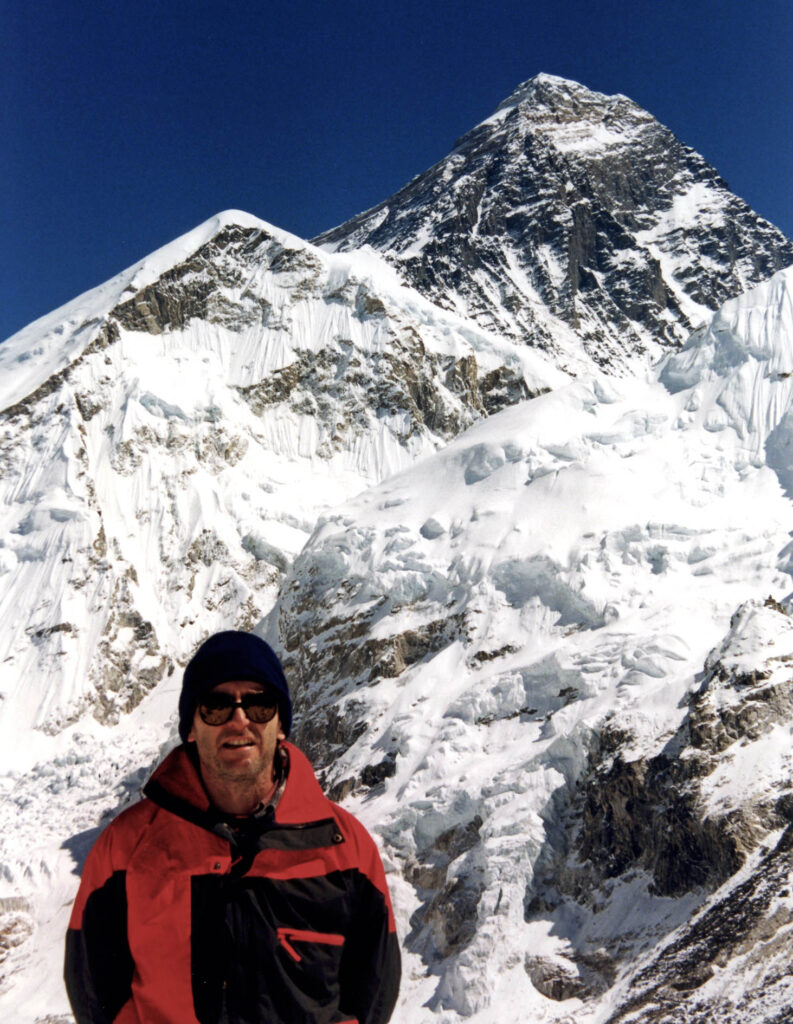
In 1999 I decided to go back to Nepal for another trek with World Expeditions. Having completed an Annapurna Dhaulagiri trek the previous year I decided to try the Everest region this time the 13 day Gokyo Lakes trek. I was also travelling with a mate of mine, Brett, who was travelling to Nepal for the first time. On the way to Nepal we decided to spend a few days in Singapore. We breezed through Changi Airport and arrived at our hotel less than an hour after landing. It’s an amazing place Singapore, very clean, safe, efficient, and orderly. We took in the usual tourist sites such as, Sentosa Island, Orchid Gardens, Little India, Chinatown district, Raffles Hotel and Boat Quay. The food is excellent in Singapore but the alcohol is rather expensive. We found the Lucky Plaza in Orchard Road a convenient place for breakfast. For good food, beer and atmosphere the Maxwell Road food pavilion was excellent – though with no air conditioning it gets quite hot and steamy – which means more beers. Dinner in the outdoor restaurants along the Boat Quay was a bit expensive but the place had a nice atmosphere at night. Of course we really shouldn’t have been drinking prior to the trek but what the heck, we were on holidays. Getting around town was cheap and easy, especially using the very efficient underground train system called the MRT. We went into the Singapore airlines office to re-confirm our flight and somehow we scored business class seats to Kathmandu. You really appreciate the extra space in business class. We also had a window seat on the right hand side so we had great views of the Himalayan mountains, including Mount Everest, as we approached Kathmandu airport.

Well what a stark contrast between Kathmandu and Singapore. The order and cleanliness gives way to dust, rotting rubbish, and chaos. Our mini bus even broke down on the way to the hotel. It’s an amazing place Kathmandu but best in small doses. I couldn’t wait to get out of the city and start trekking in the fresh mountain air. We stayed at the Radisson Hotel, a luxurious oasis that seemed a bit out of place in Kathmandu. Of course the occasional failures in electricity supply remind you that you’re still in Nepal. The hotel was only 15 minutes walk from Thamel, the main tourist area, and was a great sanctuary to return to each night to escape the heat, dust, smell, noise and street hawkers of Kathmandu. Mind you, the conditions are worse in India. Brett and I then spent the next few days visiting the temples and old cities of Kathmandu. Bhaktapur is a great place to visit. Make sure you take a local trolley bus out to the old city. It’s a slow but fascinating trip. In preparation for the trek we did lots of walking around Kathmandu but also a lot of drinking – being a tourist is thirsty work. One of my favourite places to enjoy a Carlsberg beer is the Pagoda restaurant in Patan. A great place to sit back, relax and watch the sun set. We had a speedy and exciting ride back to the hotel in a Tuk Tuk. Brett was laughing and carrying on which just made the driver go even faster.

We had our introductory meeting for the World Expeditions trek on the grass at the back of the Radisson Hotel. Our trek leader was a tall Indian guy from Kashmir called Rauf. He had worked for over 15 years with World Expeditions and I was grateful that we had an experienced and friendly guide to lead our trek. There were 15 people on the World Expeditions trek, mostly from Victoria and South Australia, plus 3 Pommies and 3 Kiwis. After the meeting we received our barrel bags in which we had to pack all our belongings for the trek, including a sleeping bag and feather down jacket. It’s always a dilemma, the night before the trek in the hotel room packing your bag for the fifth time. Should I take that extra jacket, how many socks will I need, have I got enough t-shirts.
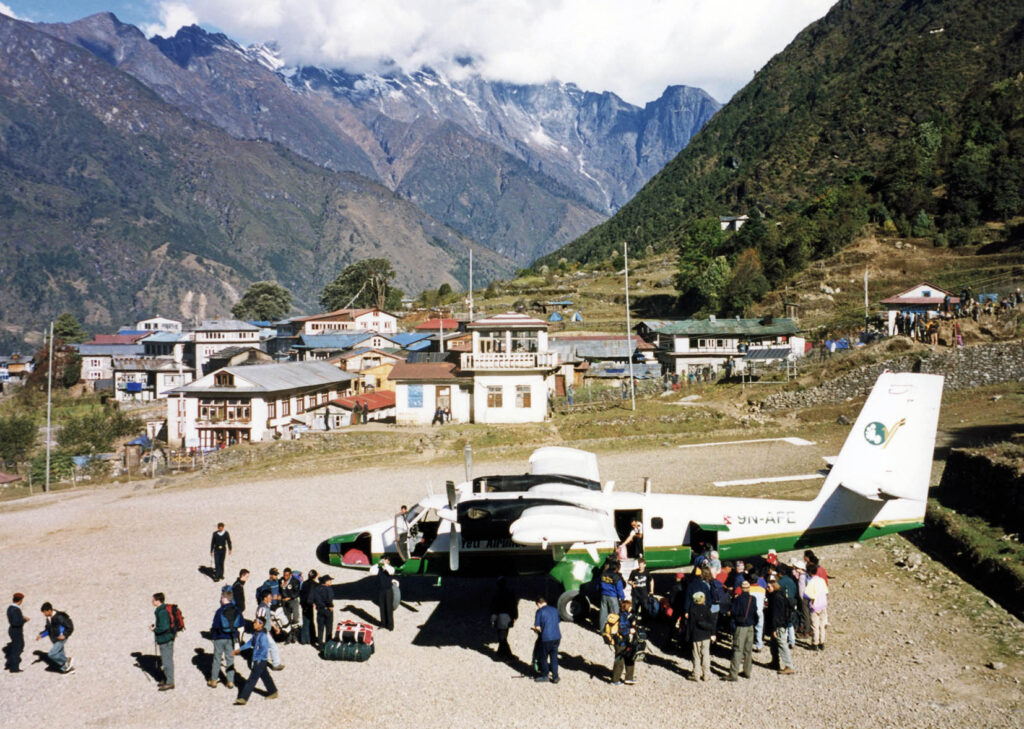
There was a delay at Kathmandu airport for a few hours but eventually the weather cleared in Lukla and we were able to board the small fixed wing small plane for our harrowing 35 minute flight. The Yeti airlines hostess handed out cotton wool (to put in your ears) and lollies before take off. No in flight movies I’m afraid but there were good views of the Himalaya out the left hand side of the plane. Landing at Lukla (2,800m) is an exciting and scary experience as the plane dips sharply to land on a short gravel runway. We had some cloud and rain in the first few days of the trek and, as expected this time of year, lots and lots of people on the trail. The first night we camped at Phakding and then onto Monjo (2,850m). The walking is fairly easy until you start the steep climb up to Namche Bazaar (3,440m). On the way up we had our first glimpse of Mount Everest in the distance. We finally arrived at Namche and then realised we had another strenuous 30 minute walk to reach the campsite, which was located at the very top of Namche Bazaar. Damn. Our campsite was positioned next to the Nepalese Cultural museum which is worth a visit. We spent two nights at Namche with a day walk to Thame village to help us acclimatise. There are lots of people at Namche this time of year so tent space is at a premium and it’s also the last chance for a decent shower.
Cloud and rain accompanied us again as we left Namche and hit the trail. We had lunch at Mong La pass and afterwards a short downhill walk to Portse Tenga (3,600m), where we camped beside the Dudh Kosi (milk river). The next morning the steep trail was very crowded as we left Portse Tenga and headed towards Dole. However, the weather cleared sufficiently to allow us views of Tawoche and Thamserku mountains. There is not much at Dole, just a few lodges on the side of a hill. Tip: Don’t rest your backpack against the outside of the lodge wall as it is covered in Yak dung. Congratulations were in order as everyone was now in the 4,000 metre club. As we headed for Machhermo the weather worsened and the light rain turned to light snow, which later turned to heavy snow and then it wouldn’t stop snowing.
Snowed in at Macchermo
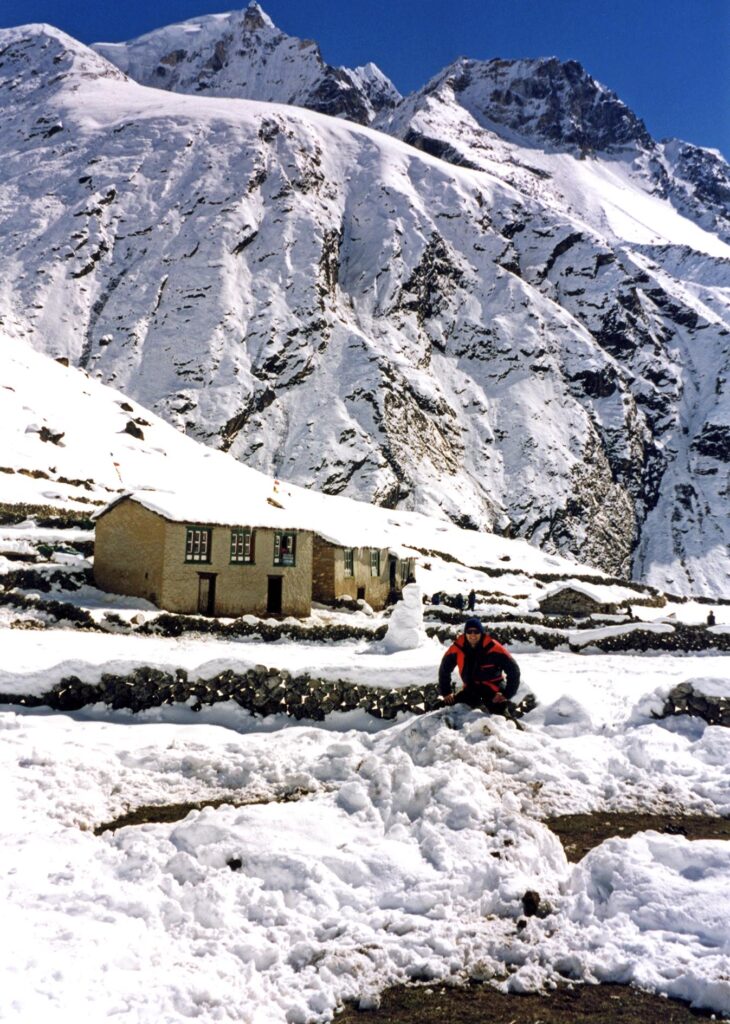
On our first night at Machhermo (4,410m) it snowed heavily all night and the Sherpas had to bang the sides of the tent all night so the tents wouldn’t collapse. This disrupts the sleep patterns somewhat of both the trekkers and the Sherpas so our leader put us in lodges for the next two nights. The snow continued to fall and fall and fall and we were all thinking that we would be stuck in Machhermo for the rest of our trek. Everyone tried to entertain themselves with card games, reading, snow fights and building snow figures but it is hard not to become a bit bored stuck in a small smoky lodge in a remote place for 3 days. The worse part was you couldn’t even go out and drown your sorrows. Brett and I tried to create a Tasmanian Tiger or Thylacinus cynocephalus (now extinct) from the snow, however, it looked more like a pit bull terrier. Our leader kept telling us that the snow falls were most unusual for this time of year.
Unfortunately I was quite sick during our extended stay in Machhermo and I spent many long hours in the cold and isolated blue toilet tent which got progressively smaller and smaller each day as the snow and ice built up all around it. Nice view of the valley though from the toilet tent… when it wasn’t snowing. On advice from the group leader I ended up taking antibiotics, which soon sorted things out and I was on my way to better health. However, I had lost a lot of weight and energy as I skipped many meals or just had soup for dinner. I generally don’t eat much at higher altitudes anyway so by the time I got back to Kathmandu at the end of the trek I looked rather skinny and gaunt. Eventually the snow decided to stop falling and the sun came out and we could see the beautiful mountains surrounding Machhermo. Then I had another problem. Sore eyes from the sun’s reflection on the snow. Good grief. Luckily I was able to borrow a pair of good quality Bolle sunglasses.
As we had lost a few days from our itinerary and we could not cross the Cho-Lu pass due to the dangerous snow conditions it was decided to retrace our steps back towards Portse Tenga and continue up to Kala Patthar for views of Mount Everest. This meant that we missed out on Gokyo Lakes but I don’t think anyone in the group was keen on hanging around Machhermo for several days until the snow had melted sufficiently for trekking to Gokyo. Most people in the group considered climbing up Kala Patthar to see Mount Everest at relatively close range as the major highlight of the Everest Circuit trek. Most of us were prepared to walk back but some clients on the trek were concerned about safety and so a decision was made that we would be evacuated by Russian helicopter back to Namche. They don’t issue radios to the trek leaders so a sherpa had to trek back to Namche to order the helicopter. Mind you, just because you order a helicopter doesn’t mean that one will actually arrive. That is the way of things in Nepal.
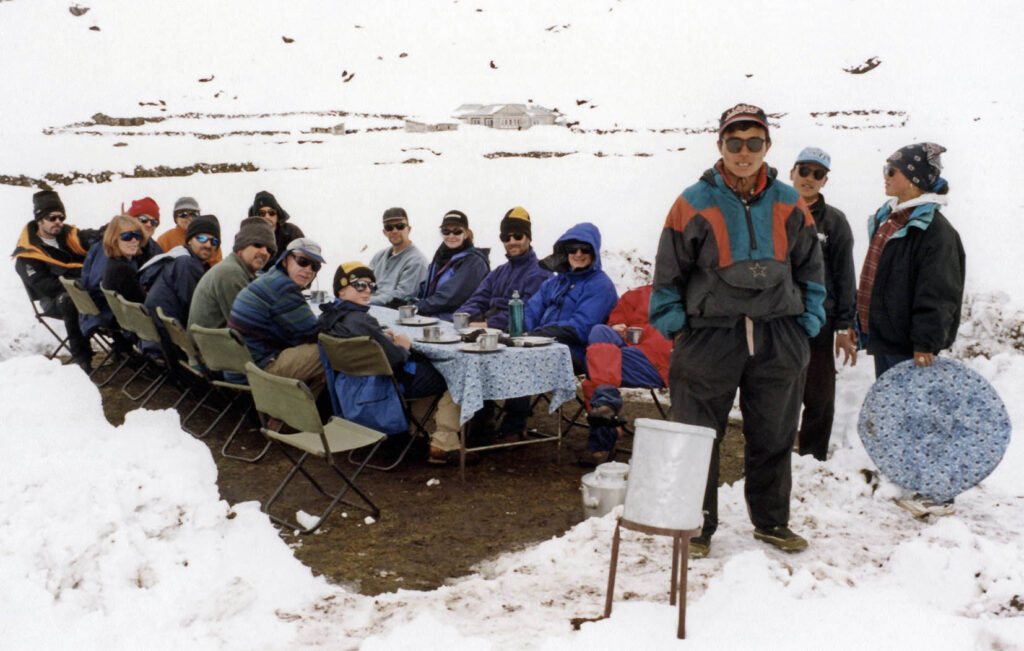
Evacuation by Russian Helicopter
Evacuation day turned out to be a beautiful bright and sunny day. The chopper was due to arrive about 7am but after a few hours of waiting we ended up having lunch outside on the small landing area cleared of snow. At 2pm our leader Rauf decided that we had waited long enough and so we started walking down the hill towards Dole. No sooner had we headed off down the trail when we heard the chopper coming up the valley and we all ran back towards the landing area. Actually that was not such a good idea as we got sprayed with flying snow and ice. I was sort of relieved to see the helicopter as I had a splitting headache from the sun and was still feeling quite unwell. I certainly would have struggled walking on a snow covered trail for several hours. On the other hand, it was a very old Russian helicopter and we were in Nepal where they have lots of accidents. So I was quite happy to take the third sortie in the aging Russian aircraft as I thought by then the pilot should be familiar with the terrain and know what he is doing.
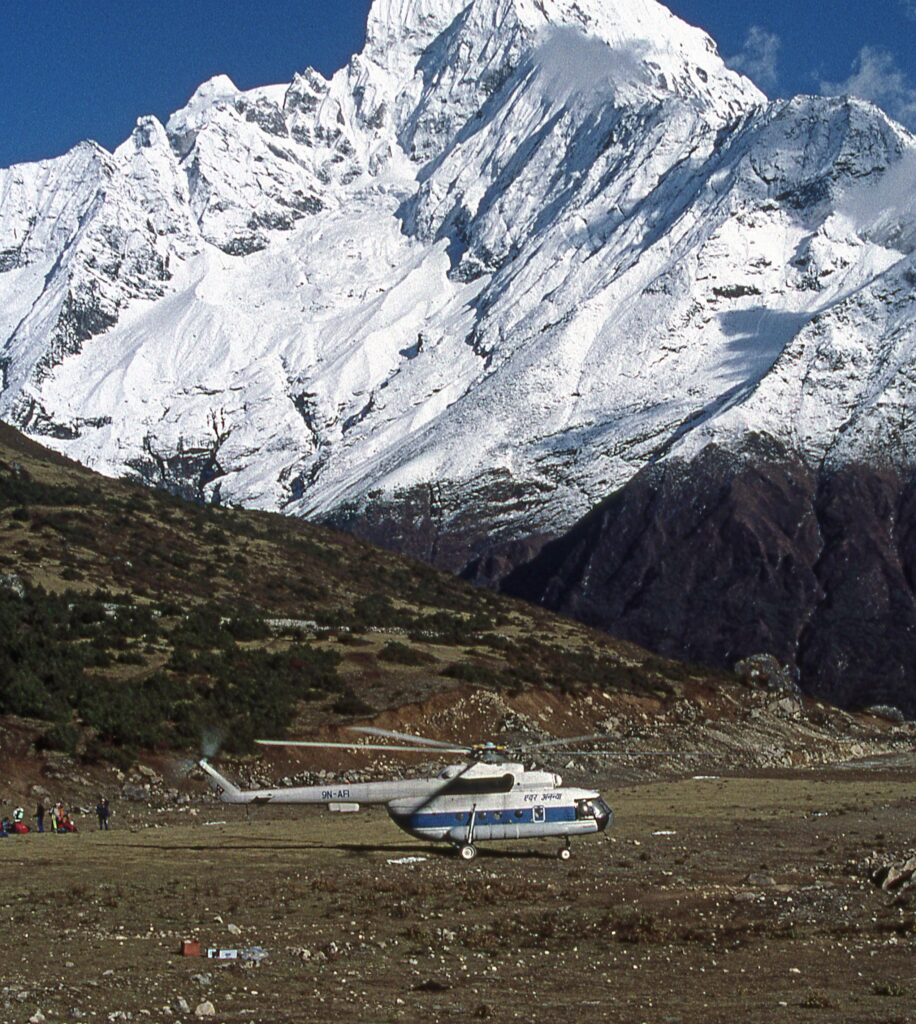
There was great confusion and pandemonium during the evacuation as we had to fly out two trek groups, kitchen staff, sherpas and luggage. The Russian crew allegedly could not speak English or Nepalese and our leader was yelling and arguing with them as he tried to get more people and equipment on board for each sortie. On the first run the pilot lifted the helicopter about four feet off the ground then brought it down and put his hand out the window to indicate four more people could come on board. When the helicopter eventually took off it disappeared very quickly into the valley. I was waiting for the explosion but thankfully there were no disasters and we all made it back safely to Syangboche, just above Namche. What had taken us several days to trek only took several minutes to fly and I was very relieved once we had landed on terra firma. That night we ended up staying at Phinjo lodge, next to the airstrip. But not before walking all the way down to Namche only to return back up the steep trail to Syangboche. Still, we needed to keep up our fitness. Everyone was grateful to be staying at a nice lodge and while we were drinking our warm cordial the leader handed out lots of chocolates. We all had showers that night and our leader allowed us to have a beer after the drama of the last few days.
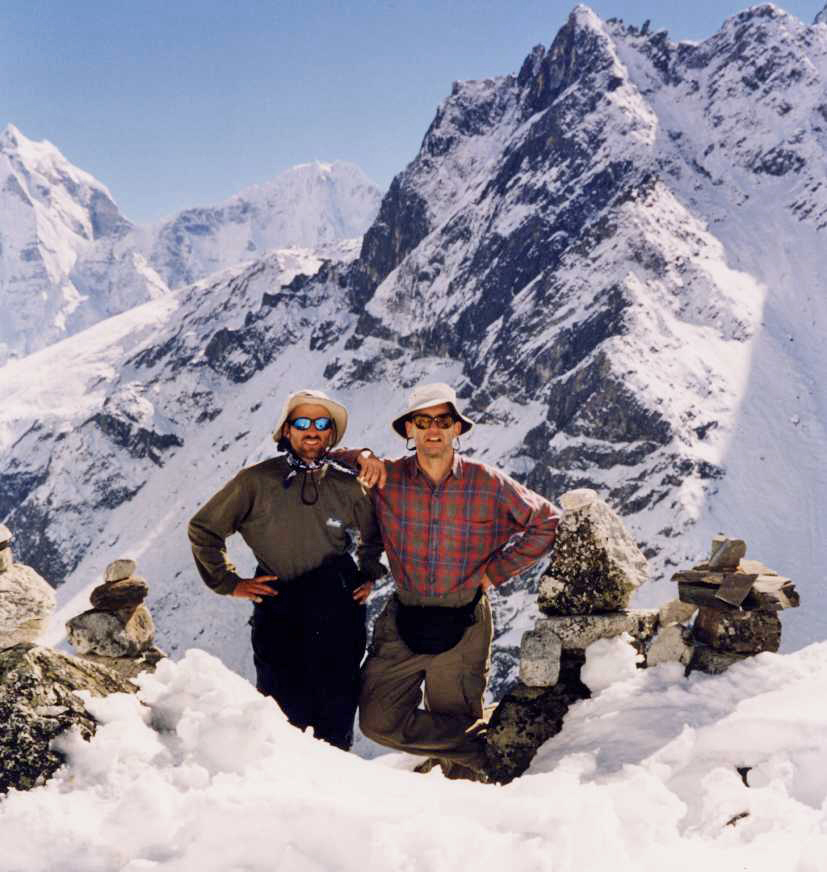
The bright sunny weather meant we finally had good views of the mountains and could start doing some serious photography. Some of the mountains surrounding Namche include Khumbila, Konde Ri, Thamserku, Kangtega, and one of my favourites, Ama Dablam. Departing Syangboche we headed up the hill towards the Japanese built Everest View hotel, which even had a helicopter and landing pad. Nothing like a steep climb first thing in the morning to get the circulation flowing… and leave you gasping for breath. The view back down the valley towards Lukla was fantastic. We had lunch at Phunki Tenga, a scenic but crowded little village and then a steep climb to Thyangboche monastery (3,867m). There was some drama on the way up as a couple of Yaks ran off the trail and dislodged some rocks which came hurtling down the hill at great speed and nearly wiped out Brett who was walking behind me. A very close thing indeed. It was a bit misty when we arrived at the monastery and with the sun gone it started to get very cold. We hung around for a long rambling talk and then a quick tour of the monastery which was given by a German conservationist. We were even allowed to take photos inside the monastery. The monastery was burned down in 1989 but has since been rebuilt. After the tour we had a short downhill walk to our camp at Deboche but by now it was starting to get really cold. Time to break out the feather down jackets. Most nights we were in bed by 8-30 pm as the porters and kitchen staff used the dining tent for sleeping.

Our next destination was Pheriche (4,243m) and on the way up we crossed the snow line. The paths through the snow were well defined, like walking in a trench at times. In the mornings the trail would be icy underfoot, however, by lunch time it was slushy and muddy. Also the sun’s reflection off the snow caused a few headaches as well as sunburnt lips and noses. Up the end of the valley we could see Lobuche East mountain and as we headed towards Tuglha for lunch we had good views of Tawoche and Cholatse mountains. After lunch we walked up the hill and stopped at the rock memorials dedicated to climbers who have died in the region. The views back down the valley were spectacular. From there it was less than an hour’s walk into Lobuche (4,930m). Our camp was located just out of town on top of a small but steep hill. Now it was really getting cold at night, perhaps down to -10c some nights. My small plastic water bottle would almost freeze up inside the tent and you had to pry open your frozen boots each morning. I didn’t mind the cold or snow that much except it really affected my feet. One morning my feet were that frozen that I found it difficult to walk. But once you start out on the trail and the sun starts to rise you soon get the circulation and feeling back in your feet.
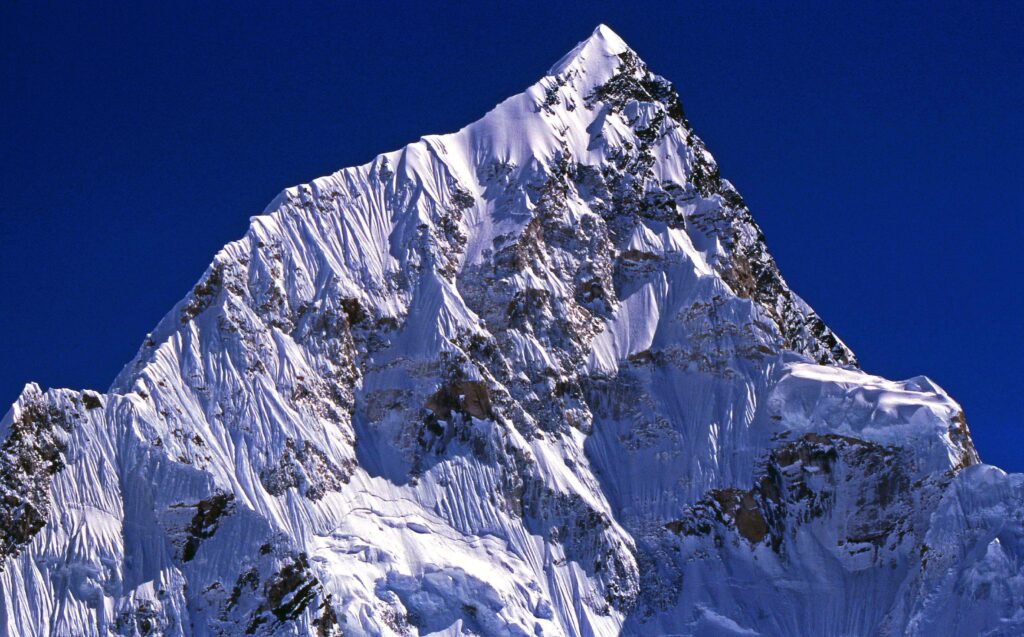
Kala Patthar
An early start for our assault on Kala Patthar but first we had a 2 hour walk to Gorekshep (5,288). Talk about cold. It was the only time I found the need to wear my balaclava. The only problem with a balaclava is that it restricts your air intake, which is not a good thing when you are trekking above 5,000 metres where the oxygen is a bit thin. We had a short break at Gorekshep before starting the slow, steep and demanding walk up Kala Patthar (5,545m). The higher you got the more rests you had to have and eventually I was having a quick break every 4 or 5 steps. In the end it becomes a mental challenge as well as a physical one.

Myself, Annabelle and Patrick were the first in our group to get to the top. Arriving first meant we had over an hour and a half to rest, take in the view, and capture it all on film. I took prints, slides and also a roll of black & white film. It was very crowded on top of Kala Patthar but that’s what you get for trekking during the peak season. I eventually found a vacant slab of rock on the far northern end of the rocky outcrop and just collapsed there for ten minutes regaining my breath, drinking water, finishing off the Toblerone chocolate bar and taking in the views of Lobuche, Changri, Pumori, Lingtren, Khumbutse, Everest, Lhotse and Nuptse mountains. The weather was perfect and as for the views… well they were spectacular, breath-taking and totally mesmerising.
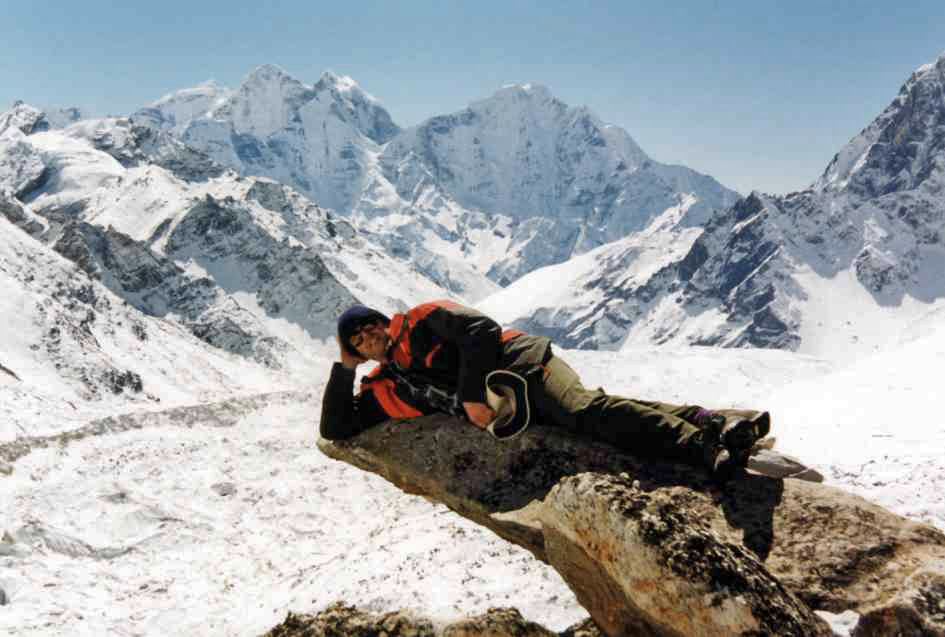
The walk back down the hill was a lot easier but quite slippery in parts due to the melting snow. After lunch at Gorekshep we still had to walk for over two hours in the snow and hot glaring sun back to Lobuche. And just when you thought it was all over there was that damn steep hill that had to be climbed to reach the campsite. Talk about trying to break the camel’s back. I actually don’t remember much about it, but I got up the hill somehow, dragged myself through the snow to the tent, took two disprin for my splitting headache and went to bed. I got up for dinner but as usual didn’t eat very much. I finished off the day with my favourite trekking drink, a Mocca (coffee and hot chocolate in hot milk). So the end of an exciting and tremendously exhausting day. Luckily no one in our group showed any signs of altitude sickness. This was probably due to the fact that we had spent a lot of time at or above 4,000 metres so our bodies had plenty of time to acclimatise to the high altitude. Early on in the trek I would sometimes wake up short of breath and have a mini panic attack as I took in some deep breaths and tried to calm down. You sort of get used to it and it disappears after a while.
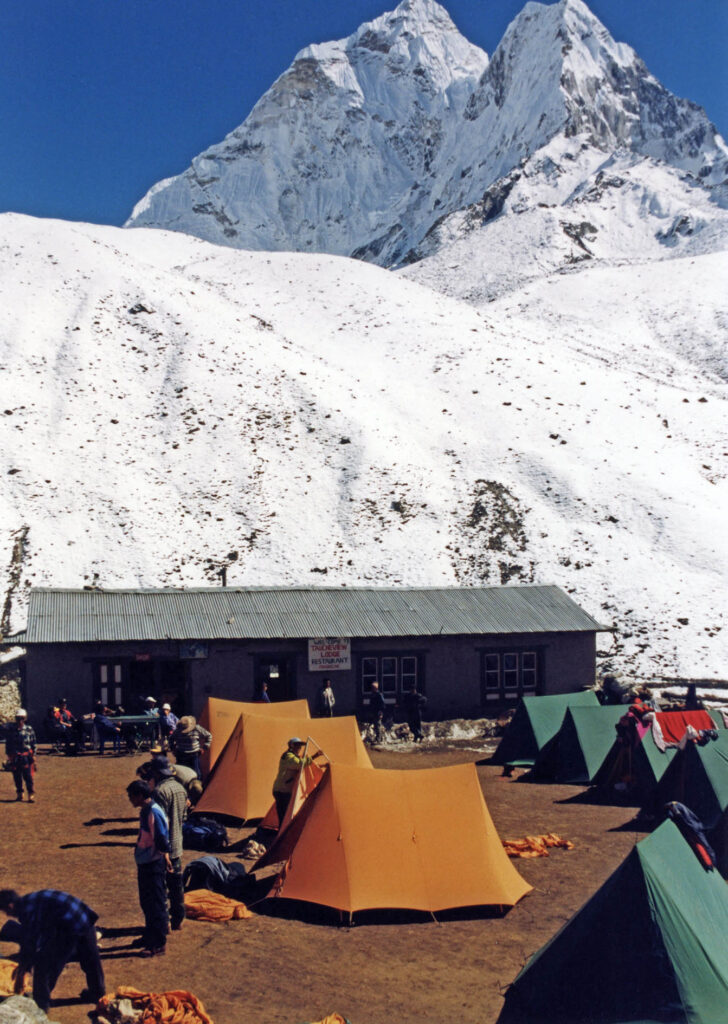
We spent two nights at Dingboche (4,530m) which allowed some of us to have a short day trip to Chhukung where we had views of Imja Tse and Cho Polu mountains. There was still lots of snow on the ground and it wasn’t until we left Dingboche that we said goodbye to snow covered trails. It is sort of disappointing once you have reached the high point of the trek and start to go downhill but on the positive side at least you can have a few beers at the end of each day. Namche especially provides a good opportunity for a few drinks and listening to 1980’s rock music.
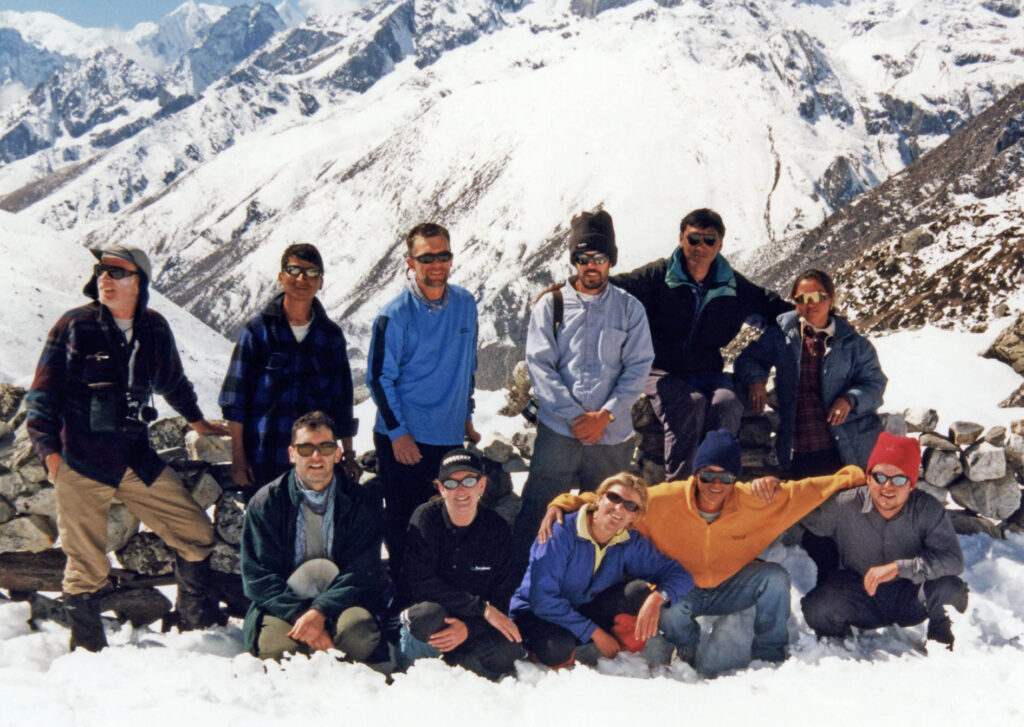
Back to Lukla
The rest of the trek back to Lukla was easy walking except the last bit into Lukla which was slightly uphill. Our last night of the trek was spent camped beside the Lukla airstrip where we had a celebration night of singing, dancing and drinking with the Nepalese porters and sherpas. It was also a chance to show our gratitude to our Nepalese friends for the hard work they performed on the trek by giving them their tip money. This trek was somewhat different to last year’s Annapurna trek. The Everest side is much steeper and harsher with less village life and agriculture. All the kids you see are children of the lodge owners so they are used to tourists and don’t want their photograph to be taken. The food was not as good as the Annapurna trek but then again the chef was fairly restricted in obtaining fresh produce. On last year’s trek we were able to get off the well worn tea-house trail for a few days but not so this year, due to the fact that we were unable to trek the Cho-lu pass.
We arrived back in Kathmandu in time to watch the French thump the All Blacks in the Rugby World Cup, which was a spectacular game. We then heard the All Blacks lost to South Africa. The three Kiwi’s from our trek were very depressed and didn’t we give it to them. After three weeks of the same type of basic Nepalese food we were all looking forward to eating something different. For our farewell dinner we went to the Fire and Ice Pizza restaurant in Thamel and later had a few beers at the Rum Doodle (40,000 and a half feet) bar.
Chitwan National Park
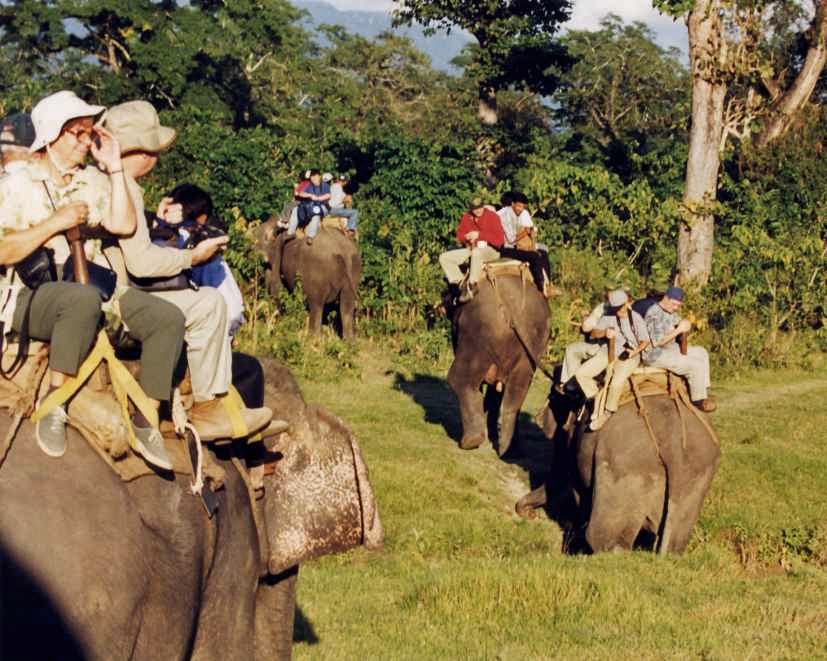
Brett and I then spent a couple of days down in Chitwan National Park staying at the Jungle Lodge inside the park itself. The highlight of the trip was charging through the bush on the back of an elephant chasing black Rhino. Myself and Katerina, a lovely Dutch girl, were facing towards the front but Brett was at the rear-end of the beast looking back and was feeling quite unwell, poor chap. I am not sure what tragedy would have unfolded if he had thrown up, or worse, on the elephant’s tail. We also had the chance to ride on the back of the elephants and take them into the river for a wash. This was great fun and very exciting but be warned, the elephants are not the only ones who get wet. Unfortunately we didn’t see any tigers in the jungle. The most dangerous part of the trip was the drive from Chitwan back to Kathmandu which takes about four and half hours, including a 30 minute lunch stop. We had a young fellow called Robin as our driver and the way he drove he obviously believed in reincarnation. Anyway, we made it back in one piece to the Radisson Hotel and we spent our last night in Kathmandu buying souvenirs and enjoying a lovely meal at an Indian restaurant in Thamel. It was called the Three … something or other
Langkawi Island
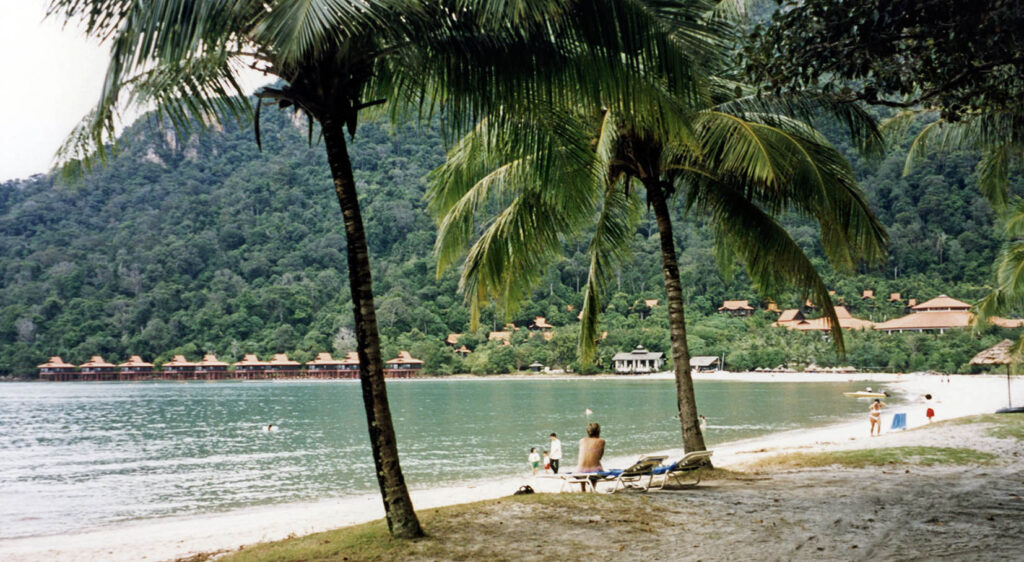
Thanks to World Expeditions we again scored business class seats from Kathmandu to Singapore. The Kiwi tribe from our trek were also on our flight but they were way down the back in economy and of course Brett went out of his way to visit them and let them know of our good fortune. Next on the itinerary was a day back in Singapore before flying out to Langkawi Island for six days of eating and drinking. Unfortunately we missed the Rugby World Cup on Cable TV as we didn’t get to the resort until 1-30am but we found out the score the next morning. We had the best positioned bungalow at the resort in Burau Bay, right on the beachfront and in prime position for Brett to perve at anything with two legs and a bikini. The weather was against us yet again, lots of cloud and some heavy rain at times. Not that I minded that much as I am not a sun worshipper and it kept the temperature and humidity down. Most evenings we ended up getting a free shuttle bus to a “sister” resort called Pelangi resort. We should have stayed at this resort as there were better sights at Pelangi but it is more expensive and quite crowded. We found a great restaurant near the Pelangi resort called the Hot Wok and had 3 fantastic meals with lots of seafood and cheap Carlsberg beer. My menu favourites included La La’s (pippies) and the Golden Spicy Crab – messy yet delicious eating. We also tried the Tiger King Prawns, which were very nice but quite expensive. At least I was able to put some of the weight back on that I had lost in Nepal. I enjoyed being able to have a swim each morning before breakfast but I find it hard to just laze around and do nothing for days on end. Though I did have a lot of postcards to write. There is not much to do in Langkawi Island, especially at the Burau Bay resort, which is the whole point of a relaxing holiday I suppose.
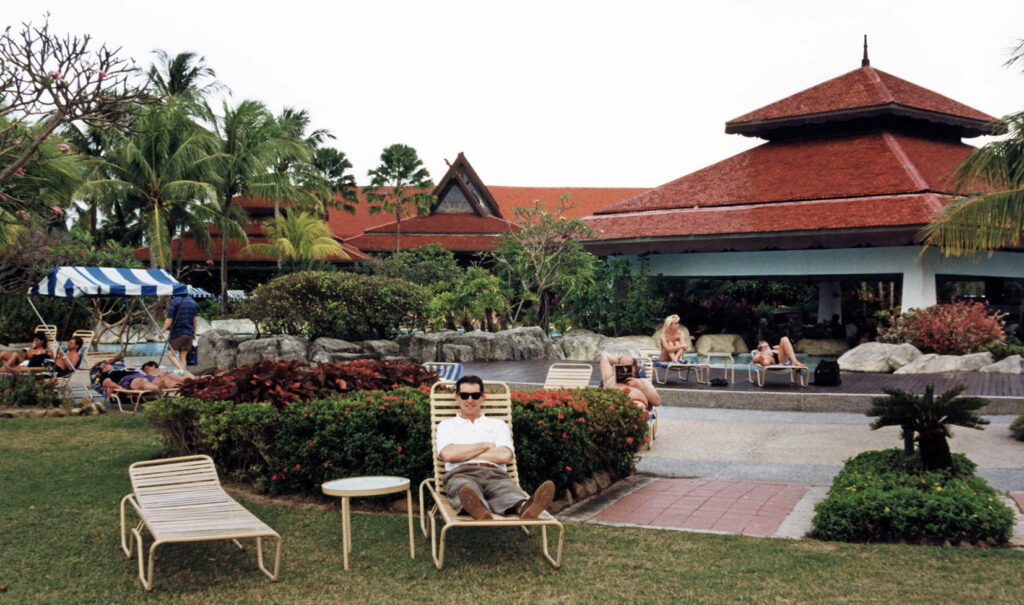
Anyway, back to reality now. There was the usual depression upon returning home to normality, routine, wearing a suit, demanding customers, and the stresses of modern day living. Still, it’s also nice to return to the little luxuries and conveniences of a modern society. Travelling to Nepal always makes you appreciate how easy we get it in Australia and other western countries. One minor problem with having such an enjoyable and relaxing holiday is when you are standing in front of the Automatic Teller Machine trying to remember your damn PIN number. As usual I have started planning my next trip which gives me something to look forward to. I am thinking of South America in 2000. Until my next trip, happy and safe travelling. Namaste.